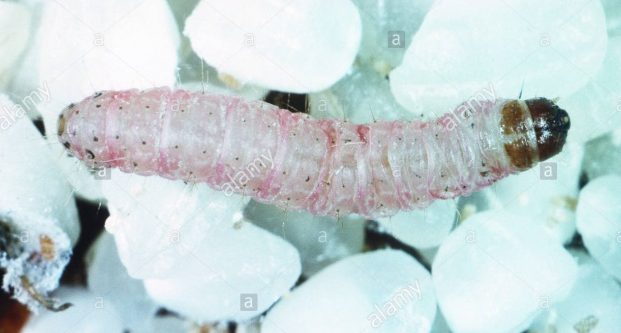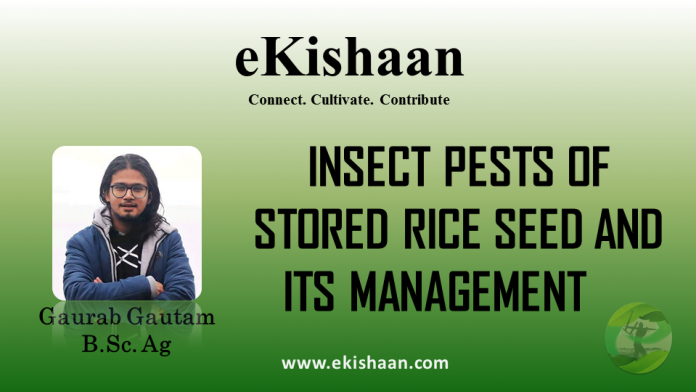INSECT PESTS OF STORED RICE SEED AND ITS MANAGEMENT
Rice (Oryza sativa) is by far the most important crop in Nepal and about half of the total agricultural area and production in the country is accounted for rice. It contributes about 7 % to GDP and 20 % to AGDP. Average yields of rice in Nepal 2.25 tonnes/ha. Rice fulfills more than 50% of the calorie requirement. It has 79% carbohydrate,7-8% protein, oil 2-2.5%, fiber 0.8%, and is a rich source of the vitamin B complex.
After all, the agronomic practices and harvesting rice is stored as per the need and requirement. There are various insects and pests from which we can get heavy loss during storage.This infestation may arise due to improper management and various other factors. Some of the insect pests seen while storing the rice and their management are :
1 . Angoumois grain moth (Sitotroga cerealella)
It is a primary pest grain feeder which belongs to the order Lepidoptera. Adults have strongly curved labial palps. They are pale grayish-brown in color and they are with a wingspan of 12 to 14 mm. The presence of adults flying nearby is an indication of an infestation. Larval feeding produces large damage within the infested grain. It does not bind grain with silks produce by it as many moths do . Infestations produce more heat and moisture that may encourage mold growth and attract secondary pests.

For the prevention against this moth the bin where the rice is kept should be treated with Tempo SC Ultra (20% cyfluthrin), apply 8-16 mL of concentrate per 1,000 square feet of bin surface and the next is Storicide II (21.6% chlorpyrifos-methyl and 3.7% deltamethrin) Fumigation is the only option of treatment if the rice is already infested with the pest. Aluminum phosphide (Phostoxin) is used for fumigation.The bin must be kept closed at least 4 days during fumigation
-
Rice weevil (Sitophilus oryzae)
It is a primary pest , grain feeder which belongs to order Coleoptera. The adults are small i.e, 2.5 to 4 mm, dark brown in color with 4 distinct reddish to reddish-yellow patches on the elytra which are their wing modifications. The adults feed on whole seeds and also on flour. Larvae develop in seeds or pieces of seeds or cereal products large enough to shelter larvae but will not develop in flour unless it has been hard or stiff. Further more feeding contributes to increase in temperature and infested grain is often damp due to moisture added by the respiration of insects.

Control of weevils involves finding and removing all infested food sources and the affected one . Rice weevils in all stages of development can be killed by freezing infested food below very low temperature i.e, -18 °C (0 °F) for a period of 3 days, or heating it to 60 °C (140 °F) for a period of 15 minutes. Applying Novacide Aerosol to kill adult Rice Weevils and cease the development of eggs and larvae.
-
Warehouse moth (Ephestia spp)
The warehouse moth which belong to ephestia spp is a drab grey colour moth with a 10-12mm wingspan. It usually only infests the surface of stored grain more over the larvae . Moths live for short period only about 2 weeks, but during the period can lay up to 200 eggs. These are distributed loosely on the grain outer surface. Larvae come out of the eggs and move over the grain surface leaving a trail of silk like structure which may form a thick mat like structure covering the surface of the infested grain. Mature larvae turn into pupa in a silk cocoon .The life cycle takes at least one month.

Basic sanitation practices such as thoroughly cleaning out bins and surrounding areas of the floors and walls to remove old grains and particles of dust can be done for the prevention . Methyl bromide was commonly used as a pesticide in several countries but was banned because of its harmful and toxic effects.
CONCLUSION
The common grain storage pest management methods practiced in the country includes (i) Inspection (ii) Sanitation (iii) Physical and mechanical (iv) Chemical. Much of the emphasis should be placed on sanitation and inspection. However the use of chemical is gaining popularity rapidly among the farmers. But use of such chemical pesticides harms our health and build up the resistance so, biological control should be practiced more often.We should not provide the favourable environment where the insect and pest can grow and in case of use of chemical pesticide we should be very careful ,read all the instructions and waits until the waiting period.

